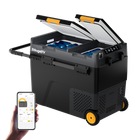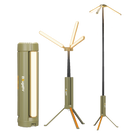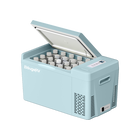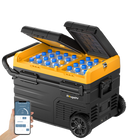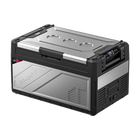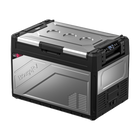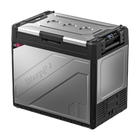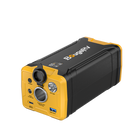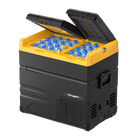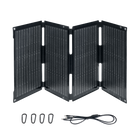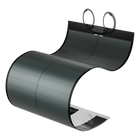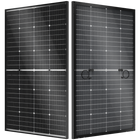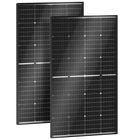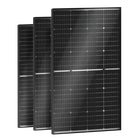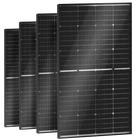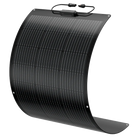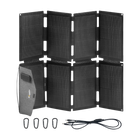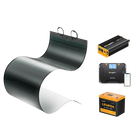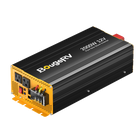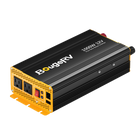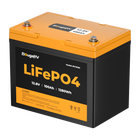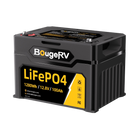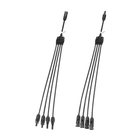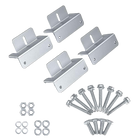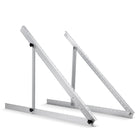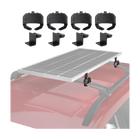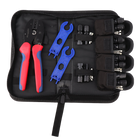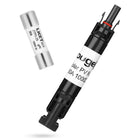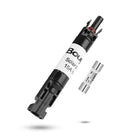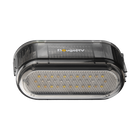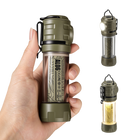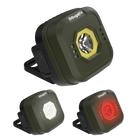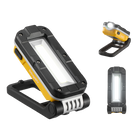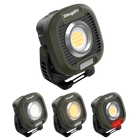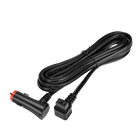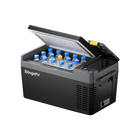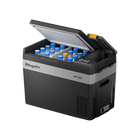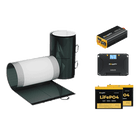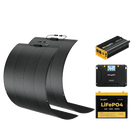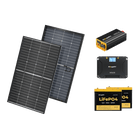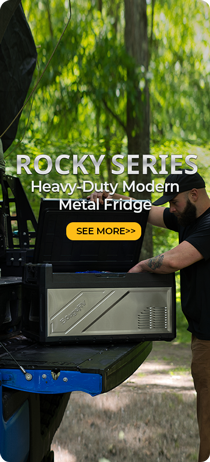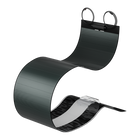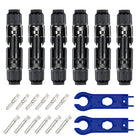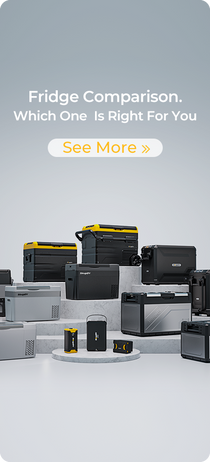CIGS Solar Panels Vs Monocrystalline Flexible Panels: Which is better?

In the world of solar power, monocrystalline solar panels have occupied the market up to a large extent. They are well admired for their high efficiency, durable design, and great value for money.
Crystalline panels are made up of silicon wafers which are no doubt worthwhile for energy generation but in the last few years, we have seen a significant shift of customers toward thin film solar cells. Compared to monocrystalline silicon solar panels, thin film panels have lower costs, good efficiency, and next-level flexibility.
- What are thin film solar panels?
- What is the CIGS solar panel type of thin film panels?
- Salient features of CIGS solar panels
- What are mono-crystalline solar panels? Why are they widely used in solar?
- Some features of Monocrystalline solar panels:
- CIGS solar panels vs monocrystalline flexible panels
- Summary
- Why Choose BougeRV?
- FAQ

What are thin film solar panels?
Thin film solar cell technology is the 2nd generation of PV modules. Its name is derived from its manufacturing process of depositing multiple thin layers of photovoltaic material onto a substrate which can be glass, metal, or plastic.
The thickness of the film is far less than that of first-generation silicon cells that are built using small wafers, only a few nanometers (nm) or micrometers (µm). This feature makes it stand out from its competitors of better flexibility and portability.
What is the CIGS solar panel type of thin film panels?
CIGS solar panels are the most efficient type of thin film solar cells that is currently available. They are also a bit expensive to produce. The CIGS thin-film PV modules are a sort of thin-film solar cells in which Copper Indium Gallium Selenide (CIGS) acts as an absorber layer for sunlight and is utilized as the main semiconductor material of panels.
These modules are made by stacking layers of different photovoltaic materials with each other and using a substrate like glass or plastic to make it flexible, transparent, and strong enough to withstand high temperatures.
Salient features of CIGS solar panels
- The high absorption rate for a large spectrum of sunlight due to direct-bandgap material
- Great efficiency among all thin film solar panels
- Mind-blowing flexibility in design and thin attractive look
- Able to compete with the performance of crystalline silicon panels
What are mono-crystalline solar panels? Why are they widely used in solar?
The monocrystalline solar panels are the result of decades of research and development. They are made from a single silicon crystal, which is packed with the power of pure silicon for capturing sunlight.
In this type, a cylindrical silicon ingot is formed from single-crystal silicon of high purity like a semiconductor which allows the movement of free electrons for maximum flow of electric current. Silicon wafers are made by slicing the cylindrical ingot constituting the shape and structure of the PV module. They are amazingly more efficient than their conventional counterparts, which makes them an ideal choice for future growth in solar energy use.
Monocrystalline solar panels are not only more efficient than conventional solar panels but also have higher energy yield rates. The efficiency of monocrystalline silicon cells is about 15-24 percent which is more than conventional polycrystalline cells. This is why they are very popular in the field of renewable energy production.
Some features of Monocrystalline solar panels:
- Monocrystalline solar panels are the most efficient type of solar panel.
- The pyramid pattern of mono panels offers a larger surface area for capturing plenty of the sun’s rays.
- Monocrystalline solar panels are the best choice for those who want to save on electricity bills
- They are clean and efficient, but they require timely maintenance and cleaning
CIGS solar panels vs monocrystalline flexible panels
1. Sunlight absorption and annual energy yield:
In CIGS panels, a layer containing Copper Indium Gallium Selenide acts like an absorbing layer and hence these modules are more sensitive to sunlight spectrum resulting in more energy yield. A 100W flexible solar panel by BougeRV can generate 10-15% more energy annually than a monocrystalline panel of the same rating.
2. Effect of 10% shadow:
Due to more light sensitivity and better absorption of sunlight, CIGS PV modules are best suited for areas with low sunlight or a shade of nearby trees. We can say that a little bit of shade won’t affect CIGS performance but in the case of flexible monocrystalline panels, 60% to 80% energy loss is observed.
3. Use a diode to stabilize the voltage
The diode is one of the most commonly used electronic components. Its biggest characteristic is unidirectional conduction, that is, current can only flow in one direction of the diode. The solar panel series diode plays a circuit protection function, which can make the solar energy more stable during operation and reduce the damage of the current to the circuit.
4. Flexibility extent:
No doubt flexible mono panels are equipped with ETFE (copolymer of Ethylene and TetraFluoroEthylene) coating for a better level of protection but the thickness of thin film CIGS PV modules is only a few micrometers (µm) or nanometers (nm) that offer super slim design and maximum flexibility than monocrystalline panels which is counted as their golden feature.
5. Micro cracking risk:
Monocrystalline flexible panels are made up of delicate silicon wafers which don’t support hassle-free transportation so they’re more vulnerable to micro-cracks while flexible CIGS panels are convenient to move, fold and use without risk of damage and reduced efficiency.
6. Lifetime and Durability:
The CIGS thin film solar panels are dedicated to use even in harsh conditions. Their strong build and durable design allow you to use them joyfully in RVs, Boats, and outdoor or camping activities. Their ingress protection enables them to withstand snow, crazy winter, and summer without being too much affected by environmental conditions hence offering up to 25 years of lifelong service with superb durability.
Monocrystalline flexible modules also support off-grid living including marine, RV, boats, rooftop, and any curvy surfaces but they can’t handle every rough and tough situation.
7. Temperature impact:
In CIGS panels, there is a 0.3% decline in power generation per degree Celsius the temperature raises but for flexible monocrystalline panels, it is up to 0.6% per degree Celsius the temperature raises which is not considered better.
8. Weight and portability extent:
CIGS panels are made up of thin photovoltaic films that’s why more lightweight (about 4 pounds) and portable than Monocrystalline panels (about 6 pounds).
Summary
Being energy consumers, we ‘have seen an energy transition from fossil fuel to renewables regarding endless advantages and free electricity. Utility rates are increasing day by day and every consumer is facing skyrocketing energy bills so taking a step towards clean green energy is the demand of this era.
Both monocrystalline and CIGS panels are highly demanded among customers but both have their pros and cons concerning efficiency, performance, and flexibility. We’ve discussed them in detail, now it’s up to you whatever you choose for your next solar project.
Why Choose BougeRV?
At BougeRV, we provide only market-leading products without compromising quality and efficiency. Our high-performance PV modules are best rated by customers and we are proud of that. We are famous for…
- Best in class Monocrystalline, CIGS, and all other PV modules
- Market competitive prices
- Tier 1 Premium PV panels and solar kits are ready to serve you anywhere
- Great customer feedback
FAQ
Which one is best among CIGS and Mono panels?
Both are equally good, CIGS panels have much more flexibility and other great features than mono panels so they are preferred in some cases due to this feature.
In which color CIGS panels are available?
Typically they're available in black, but all color panels can be manufactured, even the transparent ones as per demand.
What does CIGS stand for in solar?
CIGS stands for "Copper Indium Gallium Selenide". It's a great material for making solar panels to offer maximum absorption of sunlight for optimal energy generation.
What type of appliances can work on flexible CIGS panels?
These panels can be used to recharge laptop computers, portable refrigerators, and other electronic devices while out and about. Just connect a standard 12V battery to your Flexible Solar Panel and enjoy off-grid recharge without spending on utility bills.










